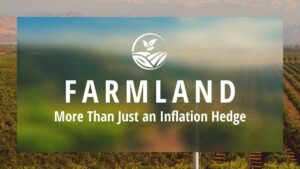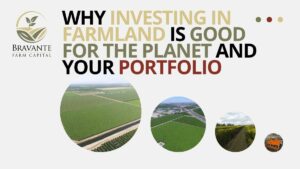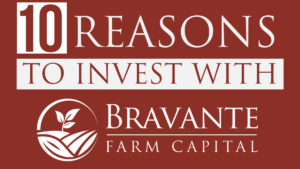Our Investment Strategy
The Farmland Investing Opportunity
Our opportunity is simple.
Climate change and unprecedented new state laws are putting extreme downward pressure on water supplies for farmers in California which puts strong upward pressure on the values of those farms and ranches that have good access to water.
Our strategy is to buy agricultural land in the California Central Valley with abundant water and great intrinsic farming fundamentals and enjoy spectacular earnings and appreciation as the rest of the valley runs out of water.
Here at Bravante Farm Capital, we are advocating a focused and disciplined investment strategy targeting a specific area of the Fresno plain in the south Central Valley which incorporates five water districts - Fresno, Consolidated, Alta, Kings River, and Madera.
These districts are sustainable long into the future featuring immense amounts of surface water coming out of the Sierra Mountains and a supercharged groundwater fed by a labyrinth of underground aquifers.
This target market is what we call the “Oasis”
Learn more about our investment strategy and join the waitlist for our next opportunity.
Factors for Success in Farmland
We know our market exceptionally well and the following factors are what are driving our success:
- Target rich environment - Within our target market there are thousands of small family farms planted with old and obsolete crops. The average age of these owners is in excess of 70 years old and in most cases have no family members interested in moving forward so selling is their only option.
- Ability to execute - The Bravante Farm Capital organization has great depth in the entire agribusiness chain of acquiring, redeveloping, farming, picking, packing and selling the commodities that flourish in our target market. We currently farm 3,900 acres and have built most of it from the ground up. George Bravante personally leads all acquisition activities and has demonstrated a keen acumen of finding great opportunities.
- Land price premium – In our target market there is a current premium to buy land when compared to the rest of the south valley. In the last year this premium has been roughly 10% or $3,000 per acre. For example, a property 15 miles away from of our target area would trade at $32,000 per acre compared to $35,000 in ours.
- Tipping point – The next five years will serve as a crossroad. The combination of climate change induced droughts, environmentalist lead water regulations and the phasing in of SGMA “Sustainable Ground Water Management” law will all come to bear greatly reducing the number of farmable acres throwing the supply and demand curve into chaos. Those with water in great farming areas win big.
The Oasis Target Market Area
Our Oasis area is comprised of the following five water districts, Fresno, Alta, Consolidated, Madera and Kings River.
- Our target market is in excess of 500,000 acres
- Most of these acres have class 1 soils
- This area has a superior microclimate for farming permanent crops
- Our target crops are as follows, citrus, table grapes, contracted wine grapes, pistachios, almonds and stone fruit
Farmland Competition
There are three kinds of competition in the market for what we are after:
- Direct competitors - There are some existing farming entities similar in stature to us that are players to buy the land we are after but they are mostly unwilling to share the opportunity with individual investors and are reluctant to borrow anything from banks. This restricts their ability to compete and does nothing to enhance their returns - other than by keeping all the profits to themselves.
- Big institutional investors - only want larger parcels that are fully redeveloped. By packaging small farms into larger parcels, and by adding value to them by redevelopment and improving the productivity, our ranches will become attractive to these deep pocketed buyers.
- Status quo – Most small time farmers are living their life oblivious to the macro trends heading their way. They are also unsophisticated and secretive about their own situation. Happy where they are and with the modest incomes they are enjoying today and have earned for generations, these owners are those whose farms we are a buying as they retire.
Join Us as We Invest Even More in Farmland
Though farming may be an unfamiliar form of real estate investing to you, there are many parallels with asset classes you already understand, like multifamily apartments for example.
Our acquisition of farms with good water supplies from farmers who have owned them for generations is similar to buying an apartment building in the path of progress with high employment and growing population from an owner who has maintained their buildings well but who has made no upgrades over the last 30 years.
That 1990's vintage apartment building owned by one owner is an ideal acquisition because in many cases the landlord has not updated kitchens or bathrooms, has added no amenities, and has kept rents artificially low because either they don't know what market rents are and do not want to invest in the building anyway because they are happy with the as-is income they are getting.
In the multifamily apartment world this is called 'value add' investing and it is the same approach we are taking to buying farms.
The fundamental difference between apartments (everyone needs a place to live) and farms (everyone needs to eat) is that the apartment market is awash with thousands of both sophisticated and unsophisticated buyers making the asset class highly competitive and consequently overpriced.
In farming, we are consolidating a highly fragmented industry in which there are very few competitors, the market is inefficient (farmland is still sold on a comparative sales basis and not based on income potential (seriously!), and that is growing exponentially as demand (population growth) expands yet supply (arable land) declines.
In short, we are consolidating a highly fragmented industry by buying value-add real estate in areas directly in the path of growth where income from crop sales and values from increased demand will earn us ongoing yields on our investments while building wealth from land appreciation over time.
Join us by signing up to our educational newsletter where we will be sharing with you updates on our acquisitions and dispositions and offering you the opportunity to invest alongside us as we build a mosaic of farms across the California Central Valley.
Learn more about our investment strategy and join the waitlist for our next opportunity.



